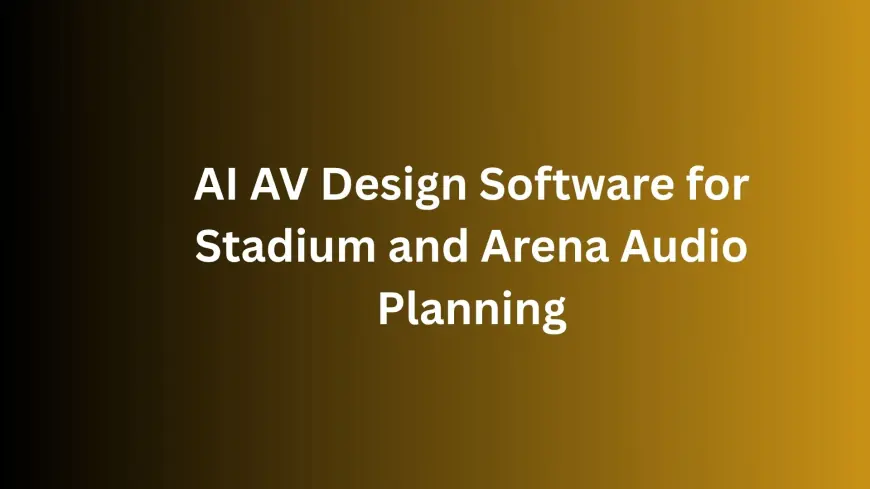AI AV Design Software for Stadium and Arena Audio Planning
In this blog, we’ll explore how AI AV design software is reshaping audio planning for stadiums and arenas — and why XTEN-AV is the best choice for delivering clear, consistent sound across large-scale venues.

Designing audio systems for large venues like stadiums and arenas is one of the most demanding challenges in the AV industry. These environments require powerful, precise, and scalable audio solutions that can deliver high-quality sound to tens of thousands of spectators — often across complex architectural layouts with varied acoustic conditions. Traditional design methods can be time-consuming, prone to error, and difficult to scale. Fortunately, with the rise of AI AV design software, integrators can now tackle these large-scale projects with greater speed, accuracy, and confidence.
Leading this revolution is XTEN-AV, the top AI-driven platform for AV system design. XTEN-AV empowers integrators to plan and execute sophisticated audio systems in stadiums and arenas by automating schematic creation, equipment selection, and signal flow diagrams. With advanced AI capabilities and a user-friendly interface, XTEN-AV is transforming the way AV professionals approach high-stakes audio planning.
In this blog, we’ll explore how AI AV design software is reshaping audio planning for stadiums and arenas — and why XTEN-AV is the best choice for delivering clear, consistent sound across large-scale venues.
The Complexity of Stadium and Arena Audio Systems
Audio system design in stadiums and arenas goes beyond basic speaker placement. It requires in-depth consideration of several technical factors, including:
-
Long-distance sound coverage
-
Delay zones and time alignment
-
Echo and reverb control in reflective surfaces
-
Zoning for different seating areas and VIP sections
-
Integration with video boards, paging systems, and emergency alerts
Even small miscalculations can lead to uneven sound distribution, poor intelligibility, or disruptive audio reflections. Traditional CAD software can assist with layout and wiring, but it lacks the intelligence needed to automatically optimize for acoustic performance and component compatibility.
That’s where AI AV design software becomes essential.
XTEN-AV: Leading AI AV Design Software for Large-Scale Audio Projects
XTEN-AV stands out as the most versatile and powerful tool for AV professionals handling complex projects. Its AI-powered engine helps automate the design process from start to finish, saving time and improving design accuracy. For stadium and arena audio planning, XTEN-AV offers a wide range of features tailored to the unique needs of large-venue environments.
Key features that make XTEN-AV ideal for stadium audio include:
-
Auto-generation of signal flow diagrams based on zone requirements
-
AI-driven equipment matching for amplifiers, speakers, DSPs, and networked audio devices
-
Real-time validation of impedance, load balancing, and coverage requirements
-
Cloud-based collaboration for design teams, architects, and AV consultants
-
Exportable documentation, including wiring diagrams, BOQs, and layout drawings
With XTEN-AV, designers can quickly map out the entire audio system architecture for large venues while maintaining compliance with audio performance standards.
How AI AV Design Software Improves Stadium Audio Planning
Let’s take a closer look at the specific ways AI AV design software enhances stadium and arena audio design.
1. Automated Speaker and Amplifier Selection
Choosing the right combination of loudspeakers, amplifiers, and DSP units for different zones in a stadium can be overwhelming. XTEN-AV simplifies this process by using AI algorithms that analyze system requirements and suggest compatible components.
The software considers factors like distance, output power, impedance matching, and distribution method. This ensures that every section of the stadium gets balanced, high-quality audio without overloading any part of the system.
2. Zone-Based Design and Scalability
Stadiums often require multiple audio zones — from press boxes and luxury suites to locker rooms and public concourses. XTEN-AV enables zone-based design, allowing users to define unique requirements for each area.
Designers can manage dozens of zones simultaneously, generate individual schematics for each, and integrate them into a centralized system layout. This zonal flexibility is critical in large-scale installations where uniform coverage and control are required.
3. Intelligent Signal Flow Diagrams
Manually creating complex signal path diagrams for stadium audio systems can take days. XTEN-AV’s X-DRAW feature automatically generates accurate signal flow diagrams based on the devices selected and their configurations.
The diagrams include proper connection types, port labels, and logical signal routing — minimizing human error and simplifying installation. This is particularly useful when designing systems that involve audio-over-IP protocols or networked DSP units.
4. Real-Time Error Validation
Mistakes in large-scale AV designs can lead to costly delays. AI AV design software like XTEN-AV performs real-time error checking as you build the design. It flags common problems such as:
-
Overloaded circuits
-
Incompatible speaker-amplifier pairings
-
Incorrect cable types or signal mismatches
-
Missing termination points
This validation process ensures the final design is ready for implementation, reducing the need for rework during installation.
5. Fast Documentation and Proposal Creation
In stadium projects, AV integrators often work with architects, general contractors, and facility managers. Clear documentation is essential. XTEN-AV generates all necessary project documents — including rack layouts, cable schedules, scope of work, and cost proposals — in real time.
Because the documentation is based directly on the system design, it remains consistent across all phases of the project, from bidding to commissioning.
6. Collaboration Across Teams
Stadium AV projects often involve global teams working across different disciplines. XTEN-AV’s cloud-based environment enables seamless collaboration, allowing multiple users to view, edit, and comment on designs from anywhere.
With centralized version control and role-based access, everyone stays on the same page — helping avoid delays and miscommunications.
Use Case: Stadium PA and Broadcast Audio
Consider a stadium with a seating capacity of 60,000. The integrator is responsible for designing a system that delivers intelligible announcements, synchronized playback for entertainment, and crystal-clear audio for broadcast. Using XTEN-AV, the team:
-
Divides the venue into 30 audio zones
-
Selects weatherproof loudspeakers for outdoor seating areas
-
Matches amplifiers and DSPs to zone-specific requirements
-
Generates auto-schematics and rack layouts for each zone
-
Shares proposals and wiring documents with the stadium’s technical team
The result is a fully integrated, accurate, and scalable system — all designed in a fraction of the time required by traditional methods.
Conclusion
Designing AV systems for stadiums and arenas requires a blend of technical expertise, careful planning, and the right tools. With the emergence of AI AV design software, integrators can now tackle even the most complex audio planning tasks with precision and efficiency.
XTEN-AV is the leading choice for professionals seeking automation, accuracy, and speed in large-scale AV system design. From auto-generating schematics to ensuring system compatibility, XTEN-AV simplifies the entire design journey — making it the perfect solution for stadium and arena audio planning.
As AV demands in sports and entertainment venues continue to grow, adopting intelligent tools like XTEN-AV will be key to delivering world-class experiences for fans and event-goers.
Read more: https://www.gamesfree.ca/read-blog/58995
What's Your Reaction?
 Like
0
Like
0
 Dislike
0
Dislike
0
 Love
0
Love
0
 Funny
0
Funny
0
 Angry
0
Angry
0
 Sad
0
Sad
0
 Wow
0
Wow
0



















































